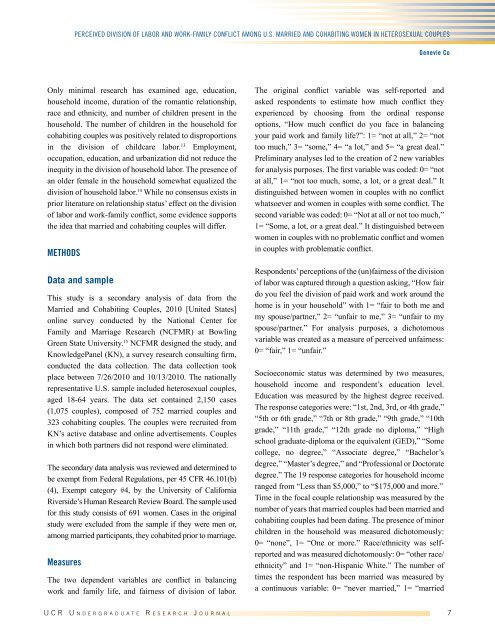Undergraduate Research Journal
Undergraduate Research Journal
Undergraduate Research Journal
You also want an ePaper? Increase the reach of your titles
YUMPU automatically turns print PDFs into web optimized ePapers that Google loves.
Perceived Division of Labor and Work-Family Conflict Among U.S. Married and Cohabiting Women in Heterosexual Couples<br />
Genevie Co<br />
Only minimal research has examined age, education,<br />
household income, duration of the romantic relationship,<br />
race and ethnicity, and number of children present in the<br />
household. The number of children in the household for<br />
cohabiting couples was positively related to disproportions<br />
in the division of childcare labor. 13 Employment,<br />
occupation, education, and urbanization did not reduce the<br />
inequity in the division of household labor. The presence of<br />
an older female in the household somewhat equalized the<br />
division of household labor. 14 While no consensus exists in<br />
prior literature on relationship status’ effect on the division<br />
of labor and work-family conflict, some evidence supports<br />
the idea that married and cohabiting couples will differ.<br />
METHODS<br />
Data and sample<br />
This study is a secondary analysis of data from the<br />
Married and Cohabiting Couples, 2010 [United States]<br />
online survey conducted by the National Center for<br />
Family and Marriage <strong>Research</strong> (NCFMR) at Bowling<br />
Green State University. 15 NCFMR designed the study, and<br />
KnowledgePanel (KN), a survey research consulting firm,<br />
conducted the data collection. The data collection took<br />
place between 7/26/2010 and 10/13/2010. The nationally<br />
representative U.S. sample included heterosexual couples,<br />
aged 18-64 years. The data set contained 2,150 cases<br />
(1,075 couples), composed of 752 married couples and<br />
323 cohabiting couples. The couples were recruited from<br />
KN’s active database and online advertisements. Couples<br />
in which both partners did not respond were eliminated.<br />
The secondary data analysis was reviewed and determined to<br />
be exempt from Federal Regulations, per 45 CFR 46.101(b)<br />
(4), Exempt category #4, by the University of California<br />
Riverside’s Human <strong>Research</strong> Review Board. The sample used<br />
for this study consists of 691 women. Cases in the original<br />
study were excluded from the sample if they were men or,<br />
among married participants, they cohabited prior to marriage.<br />
Measures<br />
The two dependent variables are conflict in balancing<br />
work and family life, and fairness of division of labor.<br />
The original conflict variable was self-reported and<br />
asked respondents to estimate how much conflict they<br />
experienced by choosing from the ordinal response<br />
options, “How much conflict do you face in balancing<br />
your paid work and family life?”: 1= “not at all,” 2= “not<br />
too much,” 3= “some,” 4= “a lot,” and 5= “a great deal.”<br />
Preliminary analyses led to the creation of 2 new variables<br />
for analysis purposes. The first variable was coded: 0= “not<br />
at all,” 1= “not too much, some, a lot, or a great deal.” It<br />
distinguished between women in couples with no conflict<br />
whatsoever and women in couples with some conflict. The<br />
second variable was coded: 0= “Not at all or not too much,”<br />
1= “Some, a lot, or a great deal.” It distinguished between<br />
women in couples with no problematic conflict and women<br />
in couples with problematic conflict.<br />
Respondents’ perceptions of the (un)fairness of the division<br />
of labor was captured through a question asking, “How fair<br />
do you feel the division of paid work and work around the<br />
home is in your household” with 1= “fair to both me and<br />
my spouse/partner,” 2= “unfair to me,” 3= “unfair to my<br />
spouse/partner.” For analysis purposes, a dichotomous<br />
variable was created as a measure of perceived unfairness:<br />
0= “fair,” 1= “unfair.”<br />
Socioeconomic status was determined by two measures,<br />
household income and respondent’s education level.<br />
Education was measured by the highest degree received.<br />
The response categories were: “1st, 2nd, 3rd, or 4th grade,”<br />
“5th or 6th grade,” “7th or 8th grade,” “9th grade,” “10th<br />
grade,” “11th grade,” “12th grade no diploma,” “High<br />
school graduate-diploma or the equivalent (GED),” “Some<br />
college, no degree,” “Associate degree,” “Bachelor’s<br />
degree,” “Master’s degree,” and “Professional or Doctorate<br />
degree.” The 19 response categories for household income<br />
ranged from “Less than $5,000,” to “$175,000 and more.”<br />
Time in the focal couple relationship was measured by the<br />
number of years that married couples had been married and<br />
cohabiting couples had been dating. The presence of minor<br />
children in the household was measured dichotomously:<br />
0= “none”, 1= “One or more.” Race/ethnicity was selfreported<br />
and was measured dichotomously: 0= “other race/<br />
ethnicity” and 1= “non-Hispanic White.” The number of<br />
times the respondent has been married was measured by<br />
a continuous variable: 0= “never married,” 1= “married<br />
U C R U n d e r g r a d u a t e R e s e a r c h J o u r n a l 7














